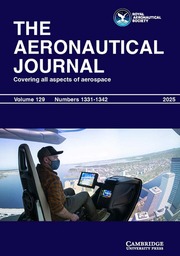Article contents
Multi-sensor data fusion for helicopterguidance using neuro-fuzzy estimationalgorithms
Published online by Cambridge University Press: 04 July 2016
Abstract
The purpose of this paper is to describe an approachwhich performs data fusion on the output ofmultiple, spatially separate, sensors engaged in thereal time tracking of obstacles in a helicopter'senvironment. The generated information can be usedeither as a flight director aid or as feedbackrequired by an automatic collision avoidance system.Obstacle track estimation has been commonly carriedout using the Kalman filter (KF) for linearestimation, or the extended Kalman filter (EKF) foruse on nonlinear problems. However, certainassumptions made in the derivation of the EKFalgorithms render it sub-optimal for aerial obstacletrack estimation. Additionally, the EKF has problemswith initialisation and divergence (stability) formany non-linear processes.
Research at the University of Southampton hashighlighted a link between fuzzy networks andassociative memory neural networks. This link isimportant as it allows new learning rules to bedeveloped for training fuzzy rules, and learningconvergence to be proved. This paper exploresmethods of fusion of estimates using neuro-fuzzymodels, and addresses some of the weakness of theKalman filter approximation introduced by theassumptions made in its derivation.
Information
- Type
- Research Article
- Information
- Copyright
- Copyright © Royal Aeronautical Society 1996
References
- 9
- Cited by

